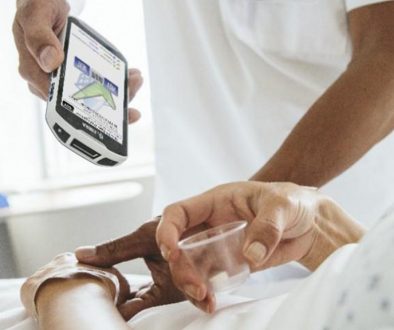Where Can Hospitals Utilize Barcode Technology In The Future?

Patient identification techniques are becoming increasingly sophisticated, with 70% of hospitals stating that they use barcoded wristbands as one of their approaches to positive patient ID (PPID)[1]. Barcoding has improved the patient identification process in a number of ways, increasing staff efficiencies, patient safety and reducing the risk of misidentification.
Barcode labels can store more information than conventional tags, as they have the ability to store data in less space than handwritten or typed text. Legibility issues are eliminated, whilst staff can process labelling faster than if they are required to manually write labels.
The patient ID advantages of barcode labelling are well documented, yet there are several areas beyond PPID where barcoding can improve healthcare processes:
Lab specimen & medication labelling
Present in two thirds of hospitals, barcoding lab specimen labelling virtually eliminates sample collection errors by removing all of the potential failure points. Criteria including collection date, time, user and the tests required are automatically recorded on barcode labels, eliminating the risk of errors as a result of illegible handwriting. Medication identification is more efficient when using barcode labelling, as it ensures labels are fully legible, trackable and easily created. Staff can conveniently identify the correct medicine and dosage with confidence, as the error rate for barcode data entry is less than one per three million scans.
Staff identification
Barcoding enables hospitals to establish a secure environment by providing high-quality identification cards with advanced security features. Two dimensional barcodes are capable of storing substantial amounts of information, including a digital photograph that can be viewed whenever the barcode is scanned. Patients can feel comfortable and secure as they are able to quickly identify their careers’ role in relation to their treatment.
Asset labelling & medical supplies
Over 50% of hospitals plan to introduce barcoding to asset labelling and medical supplies. The main incentives stem from losses of supplies and the need to improve inventory management. Deploying barcode labelling in these areas will enable businesses to reduce expenditure and give staff visibility of where hospital property is on a day-by-day basis, enabling them to utilize stock more effectively.
It’s worth noting that there are challenges that healthcare organizations must overcome in order to successfully integrate barcoding into the workplace. Our research revealed the top four perceived barriers to ID technology to be potential costs, technology integration, staff resistance and data entry errors. Given the proven benefits, it’s important for hospitals to look at how others have overcome their doubts to achieve their goals of improved patient care, increased efficiency and significant cost savings.
Not only does barcode technology ensure PPID, it also improves the process of positive specimen identification, asset tracking and medication labelling. Barcodes bring consistency and accuracy to tasks throughout the healthcare sector, whilst driving greater value from established networks.



